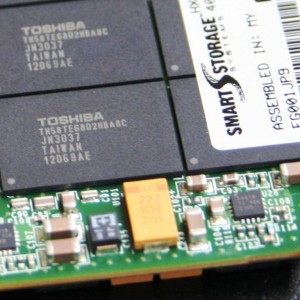REPORT ANALYSIS AND FINAL THOUGHTS
SMART’s Optimus is clearly an interesting product. While the lack of pricing information make it difficult to evaluate the value proposition, as long as it’s reasonably priced it will find success in a market headed towards the same conclusions.
Performance at steady state is fantastic, and what you see is what you get. If you see the specs on the box, you’re going to get similar performance out of the box and at steady state. In that sense, it’s more like testing a mechanical hard drive and not an SSD.
Between the firmware, flash, and overprovisioning, there isn’t any degradation in write speed as the drive gets pummeled with writes. If you’re workload is random write dependent, you know what kind of speed/ latency to expect at all times.
The Optimus does possess one feature we weren’t effectively able to evaluate, though. With the appropriate hardware and OS support, the Optimus supports a full duplex, active/active wide port mode. In this configuration, the 6gbps “speed limit” is raised to 12gbps, as two ports of the HBA are used to transfer data to and from the controller. It doesn’t affect random performance, but sequential reads can be extended up to 1GB/s. Whether it’s worth sacrificing two ports on a host bus adapter is tough to say, as we were unable to get the wide port mode working consistently enough with our test system’s operating system to gather the appropriate data in time for publication. When it was working, it worked great, but our OS may have been improperly configured. We’ll get to the bottom of it eventually, but it doesn’t change much with respect to the Optimus.
Sequential read and write speed aren’t really the main attraction anyway. Fantastically steady, predictable random performance is far more attractive for most applications, and it seems to be an Optimus hallmark. It really does perform more like an SLC-based drive, not just a drive with aspirations of better-than-MLC endurance. On a second-by-second basis, the drive outclasses nearly any MLC drive on a mixed 4K read/write workload with performance which refused to fluctuate. The results of the write saturation test were pleasingly bizarre, showing atypical performance. Simply put, random writes don’t fall off at steady state; they don’t fall off at all. Not something you see everyday. There are lots of drives which can outperform at steady state 4K writes, but none that come close to the Optimus’ probably price class.
All in all, with the transition to 3 bit-per-cell flash in the consumer arena and MLC taking a more serious role in the enterprise, the bounty of solid state storage is becoming cheaper without much sacrifice or compromise in performance. At least in the case of SMART Storage Systems, that performance is accompanied by serious endurance claims. SMART is betting that they can deliver just the right amount of speed and endurance for an application at exactly the right price. The fine line between not overpaying for too much endurance or getting caught out with too little is difficult to walk, but SMART seems intent on carrying MLC into places it’s never been before. Whether they succeed or fail is still up in the air, but delivering solid, consistent performance with the Optimus is a great place to start. We’ve looked at their SATA-based offerings in the past, but the SAS Optimus (and it’s higher endurance variants) are a certainly more unique, and more likely to carve out a niche in a cutthroat enterprise market always on the lookout to reduce total cost of ownership. If SMART can manage that, the future will be bright.
 The SSD Review The Worlds Dedicated SSD Education and Review Resource |
The SSD Review The Worlds Dedicated SSD Education and Review Resource | 


Firmware ultimately ends up being more important than the controller itself in many or most circumstances. Good FW can make a mediocre drive great, or a great drive a flaming dumpster fire.
That was beautiful, thank you for the insight. 🙂
The SSD market is RED HOT right now! Thanks Les for all the good stuff!
Reliability and predictable performance is very important. I wish consumer-oriented drives would be more like that. As a side note, what’s going on with the 12Gbps connection? Did you manage to sort it out? Perhaps it will work fine with Win7, WIn8 or Server 2012?
this is beautiful.. Wish my old kinston had the speed and reliability of this.